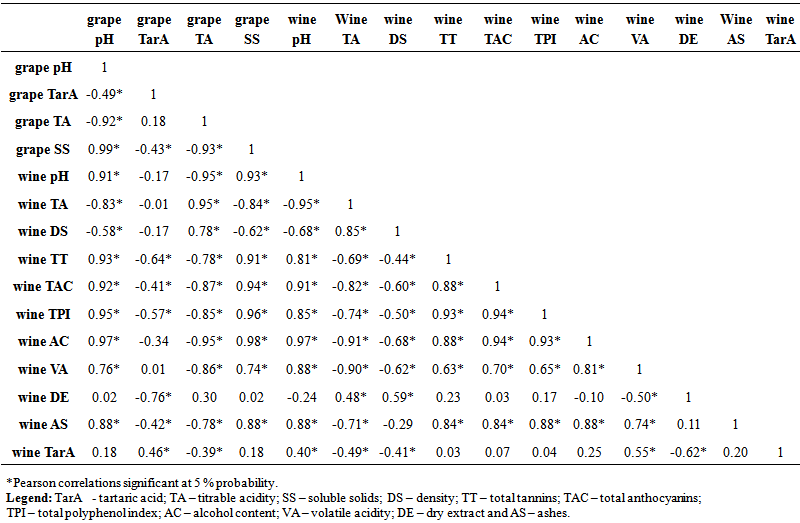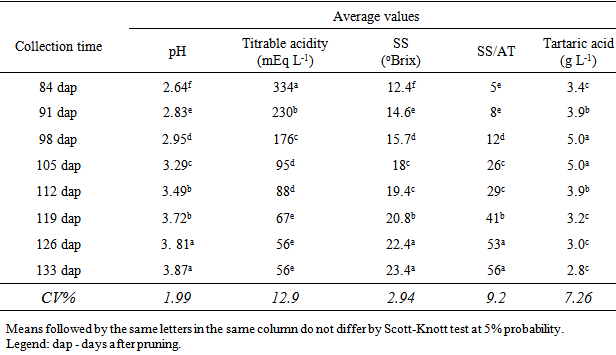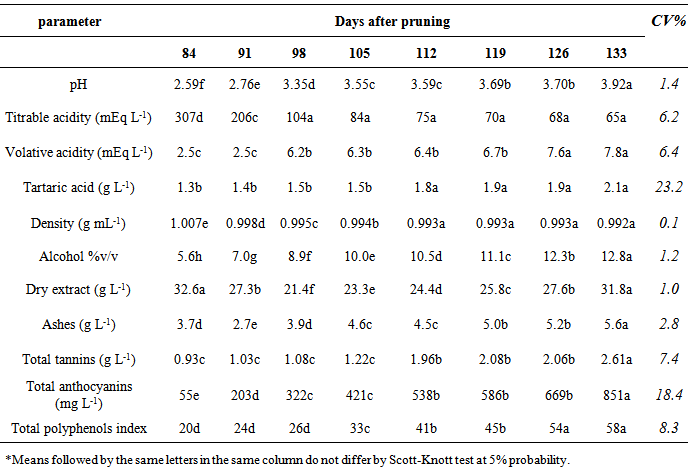-
Paper Information
- Next Paper
- Previous Paper
- Paper Submission
-
Journal Information
- About This Journal
- Editorial Board
- Current Issue
- Archive
- Author Guidelines
- Contact Us
International Journal of Agriculture and Forestry
p-ISSN: 2165-882X e-ISSN: 2165-8846
2015; 5(2): 151-159
doi:10.5923/j.ijaf.20150502.09
Influences of the Harvest Season on Analytical Characteristics of Syrah Grapes and Wines Produced in the Northeast Region of Brazil
Marcos dos Santos Lima1, 2, Amanda Priscila da Silva Leite2, Yrislane Carvalho Sampaio2, Flavio Vianello3, Giuseppina Pace Pereira Lima4
1Department of Technology and Social Sciences (DTCS III), University of Bahia (UNEB), Juazeiro - Bahia, Brazil
2Department of Food Technology, Federal Institute of Sertão Pernambucano, Petrolina - Pernambuco, Brazil
3Department of Biological Chemistry, University of Padova (UNIPD), Italy
4Department of Chemistry and Biochemistry, Botucatu Institute of Biosciences, San Paolo State University (UNESP), Botucatu, Brazil
Correspondence to: Giuseppina Pace Pereira Lima, Department of Chemistry and Biochemistry, Botucatu Institute of Biosciences, San Paolo State University (UNESP), Botucatu, Brazil.
| Email: |  |
Copyright © 2015 Scientific & Academic Publishing. All Rights Reserved.
The present study evaluated the main physical and chemical characteristics of Syrah grapes, coming from the tropical region of São Francisco river valley, harvested at different times and their relationship with analytical characteristics of resulting wines. Grapes came from the first half of 2009 harvest, collected at Casa Nova - Bahia, a semi-arid and hot region, comprising an interval from 84 days after pruning (84 dap) to the beginning of grape over-ripening, 133 days after pruning (133 dap). Harvests at 84, 91, 98, 105, 112, 119, 126 and 133 dap, were analyzed for pH, soluble solids and acidity in grapes, which were then processed for wine production. Maximum sugar/acidity ratio (s/a = 56) were observed in grapes harvested between 126 and 133 dap, coincided with the highest concentration of anthocyanins (851 mg L-1) and total tannins (2.6 g L-1) in the resulting wines, indicating that grapes collected between 126 and 133 dap showed the best potential for winemaking in the tropical climate of São Francisco river valley. This result was confirmed by the analytical characterization of wines, that, between 126 and 133 dap, showed 12.8% alcohol, 31 g L-1 dry extract, 5.6 g L-1 ashes and a TPI of 58, using only one pumping per day, for 5 days maceration. Syrah grapes considered in the present work presented a good evolution of maturation, and grapes harvested between 126 and 133 days after pruning, showed the best oenological potential for the development of red wine. The use of pH and soluble solids appeared useful parameters in the estimation of maturation degree and quality potential of grapes for winemaking.
Keywords: Grape maturation, Characterization of wines, Tropical wine
Cite this paper: Marcos dos Santos Lima, Amanda Priscila da Silva Leite, Yrislane Carvalho Sampaio, Flavio Vianello, Giuseppina Pace Pereira Lima, Influences of the Harvest Season on Analytical Characteristics of Syrah Grapes and Wines Produced in the Northeast Region of Brazil, International Journal of Agriculture and Forestry, Vol. 5 No. 2, 2015, pp. 151-159. doi: 10.5923/j.ijaf.20150502.09.
Article Outline
1. Introduction
- Tropical viticulture, aimed to winemaking and other grape and wine products, is a recent, worldwide diffused, activity. Brazil represents a pioneer in the area of tropical viticulture, currently producing around 5.0 million liters of wine per year, being the São Francisco river valley region responsible for the entire production (Mello, 2013). The region of São Francisco river valley is located in northeastern Brazil, between 8-9° latitude in the southern hemisphere, and has been developing rapidly in recent years, mainly near the cities of Petrolina, Lagoa Grande and Santa Maria da Boa Vista in Pernambuco State, and Juazeiro and Casa Nova in Bahia State (Lima et al., 2014). The region stands out on the national scene as the largest exporter of table grapes and the second largest producer of high quality wines (Lima et al., 2014). Wine grapes in this region are predominantly of European origin (Vitis vinifera L.) and, in particular, the Syrah red variety.Syrah is one of the oldest cultivated varieties. Some authors suggested that it originates from the varieties "Dureza" and "Mondeuse blanche" in southeastern France. From France, it was exported in many countries and, today it is one of the most planted red grape cultivars in the world (Bowers et al. 2000; Vouillamoz and Grando, 2006). In the hot semi-arid conditions in northeastern Brazil (São Francisco river valley), the Syrah variety has shown excellent performances, where wine is distinctive for its aroma and bouquet (Giovannini, 2009).One of the most important factor that differentiates São Francisco river valley from other traditional farming regions in the world, is the ability of plants to produce more than one crop per year. Due to the particular environmental conditions, hot climate, high luminosity and plenty of water for irrigation, winemakers in the region use to plan the period of grape harvest, adopting a scheduling system for plot pruning, and harvesting. This gives rise to different harvest periods, giving products with distinct characteristics (Teixeira et al., 2007; Lima et al., 2014). This fact means that smaller facilities can be used, that can be employed all over the year, reducing the need for inventory. Between one and another crop, irrigation is reduced to 15 to 20% of the crop coefficient, during dry periods by about 20 to 30 days (corresponding to the winter period in temperate regions), then pruning is carried out and hydrogen cyanamide application is used to homogenize the shooting. After this stage, irrigation is increased to supply 100% of the crop coefficient and a new production cycle starts. Generally, the periods of highest harvest concentration occurs between May and June and October and November (Teixeira et al., 2012). Wine production in the world is highly competitive, facing with countries with high experience, high quality and excellent image among consumer markets. Tropical wines, by contrast, have a low production volume if compared to world production. Certainly, tropical wines are unique in the world, with an identity that should be valued in the world market. The quality of a wine depends on many factors, including variety and rootstock, which are influenced by environmental factors (climate and soils) and viticultural technology (systems of cultivation, fertilization and others), and finally, the technological choices will produce the final product, wine, which express the effect of all these factors (Orduna et al., 2010). One of the key practices that interfere with the quality of wine is the determination of the right grape harvesting time. This step (desired maturation) must be indicated by easy to determine parameters, based on biochemical and/or morphological changes that occur during ripening. Some indicators are the simple count of the days after flowering or pruning, that, within a region, shows little variations for each cultivar, from year to year (Giovannini, 2009). Grape ripening analysis is one of the most effective controls that should be carried out for wine production, involving the evolution of sugars, acidity, polyphenols and aromatic compounds. More recently, in Europe the rate of phenolic maturation has been used. This gives an estimate of the best crop period and of grape destination, according to grape composition in terms of anthocyanins and tannins. Phenolic maturity takes into account the overall content of phenolic compounds, and also their structure and suitability for incorporation into wine during the maceration (Ribéreau-Gayon et al., 2003). Thus, differences appear from region to region and from different winemaking tradition, especially regarding climate, in particular in the tropical region (where the vine grows throughout the year, producing grapes in non-classical periods). For these reasons, it is necessary to improve the research work, in order to contribute to the improvement of wine quality in these regions. The present study is aimed to determine the evolution of main chemical characteristics of Syrah grapes in different harvest periods and to correlate the results with the analytical composition of the resulting wines, generating information for winemakers in the São Francisco river valley, in order improve the quality of wines by deepening the knowledge about chemical composition and enological potential of the raw material.
2. Materials and Methods
2.1. Plant Material and Treatments
- Syrah grapes were from an full production area for winemaking, located at Fazenda Ouro Verde, owned by MIOLO WINE GROUP, Santana do Sobrado, 40 BR 235 km, Casa Nova - Bahia, on the banks of the Sao Francisco river, at 09° 16' 20" South latitude and 40º 52' 8'' West longitude, approximately 360 meters above sea level. The preparation of wines and the physico-chemical and spectrophotometric characteristics of grapes and wines were carried out at the Wine School (Enology Laboratory) of the Federal Institute of Sertão Pernambucano, Petrolina Campus, Rural Zone, located at 22 Km of BR 235 road, Senador Nilo Coelho Project, Nucleus 4, Petrolina (Pernambuco). Plants used, 5 years old, were derived from the Syrah 100 clone, grafted on IAC 766 rootstock with 2.2 x 1.0 m spacing, conducted on trellising system, 60 cm high, and led to a height of 1.20 m. Plants received basic NPK fertilizer (30-30-30) once a year and a 4 liters per hour drip irrigation. The management of irrigation was used in accordance with the rate of evapotranspiration. The vines were pruned (production pruning) on February 18, 2009 and the grapes were harvested in the period from May 11 to June 29, 2009, in a weekly interval, which began 84 days after pruning (15 days after the color development) until the start of the grape over-ripening, characterized by the onset of withering of berries on the vine, 133 days after pruning (64 days after the color development). Climatic data, in the region, averages per month, collected in the period February to June 2009, from pruning to last harvest completion (133 dap). They were: temperature 25.2°C, 89.4 mm rainfall, relative humidity 78.6%, 5.6 mm evaporation, illuminance 348.7 lx/day and 8.5 hours insolation, measured at the weather station of Mandacaru (Juazeiro – Bahia, 09° 24 'S, 40º 26' W).The experimental design was completely randomized, involving 8 treatments and 3 replications, each plot comprised 20 plants. Treatments corresponded to different harvest seasons. The first harvest was 84 days after pruning (84 dap) (T1) and the others were collected at weekly intervals (91, 98, 105, 112, 119, 126 dap) until the beginning of grape over-ripening (133 dap) (T8). The results were subjected to variance analysis (ANOVA) and compared by Scott-Knott test at 5% probability using the SISVAR 4.2 statistical software (Sisvar, Brazil). Results were analyzed also by Pearson correlation at 5% probability using the SPSS 14.0 for Windows Evaluation Version (SPSS, USA).
2.2. Analytical Determinations of the Grape Must Samples
- Grape samples were subjected to physical and chemical analysis. Grape berries (n = 200) were randomly collected from different parts of the grape and from different plants, in order to be representative. The plot consisted of 20 plants, totaling 480 plants used and distributed in eight treatments and three replications. Analysis were: berry juice pH, determined by a digital bench pH-meter (Tecnal, Brazil); soluble solids (SS), using a digital Abbé type bench refractometer, and total acidity (TA) by titration following the methodology described by OIV (2011). The determination of tartaric acid was carried out on grape juice or wine in acetic acid containing ammonium vanadate, and the van do-tartrate complex was evaluated using a UV/VIS bench spectrophotometer (mod. T60, PG instruments, England) at 530 nm, following the methodology described by Matissek et al. (1998). The soluble solids/total acidity ratio (SS/TA) was calculated according to the methodology described by Togores (2006).
2.3. Analytical Determinations of Wine Samples
- Wine samples were analyzed as regard pH and titrable acidity, according to the methodology described by OIV (2011). Dry extracts were determined by sample evaporation in a water bath, followed by drying at 105°C, and ashes were determined by incineration of the solid samples at 550°C in a digital furnace (Jung, Brazil), according to the method described by AOAC (2005). Volatile acidity was determined by titration of volatile acids obtained from current vapor sample extracts, followed by rectification, using a semi-automatic volatile acidity analyzer (Tecnal, Brazil). Sample density was measured by a hydrometer for specific gravity (range 0.900 to 1.000 g cm-3, reslution = 0.001 g cm-3) at 20°C by comparison with water at 20°C. Alcohol content was evaluated by measuring the refractive index of sample distillate, at 20°C, using an Abbé type benchtop digital refractometer, as described by OIV (2011). Anthocyanins were determined according to the bisulfite bleaching technique, followed by reading the absoorbance at 520 nm, using a 10 mm path length cuvette. Tannins were determined by color development, at 550 nm in 10 mm cuvettes. Total polyphenol index was measured by diluting wine samples with water (1:100) followed by reading the absorbance at 280 nm in 10 mm cuvettes (Ribéreau-Gayon et al. 2003).
2.4. Winemaking
- For each treatment used for physico-chemical analysis, grapes (20 kg) were collected to perform a micro-vinification process, which was conducted at the Wine School of SERTÃO IF-Pernambuco. Grapes were weighed, crushed, destemmed and squeezed, then potassium metabisulfite (60 mg L-1) and selected active dry yeast (Saccharomyces cerevisiae var. Bayanus) (200 mg L-1) were added. Grape juice was incubated in 20 L glass bottles. Maceration was carried out for 5 days at 25°C, 1 pumping per day. At the end of maceration, a hand press was used, peels were eliminated, and the wine was inserted in glass bottles for continuing the fermentation, at 25°C. After the alcoholic fermentation occurrence, wines were transferred and the natural malolactic fermentation occurred, at 25°C. At the end, wine was transferred again and a correction by 30 mg L-1 sulfur dioxide was added. The clarification was carried out just by cold incubation, keeping the bottles at 8°C for 5 days, where the natural settling of the sludge occurred. After the clarification, a new wine transfer was carried out and the level of free sulfur dioxide was corrected to 30 mg L-1. Then, wines were bottled by hand in 750 mL amber glass bottles, closed with agglomerated cork stoppers using a semi-automatic corker (Ricefer, Brazil) and stored 60 days for stabilization. After the stabilization period, wine analytical determinations were performed.
3. Results and Discussion
3.1. Analytical Results on Syrah Grapes
- An increase of pH values was observed in grapes during berries maturation, starting from pH 2.64 at 84 dap, and reaching a stabilization before the over-ripening appearance at 126 dap, pH 3.8 (Table 1). The increase in pH values was accompanied by a decrease of titrable acidity (Table 1). The more pronounced reduction of acidity occurred between 84 and 105 dap, with a significant decrease from 334 to 95 mEq L-1. After 105 dap, this decline was slower, reaching a constant value starting from 119 dap with a value of 67 mEq L-1, while that in the early over-ripening (133 dap) it reached 56 mEq L-1.
|
3.2. Analytical Results on Syrah Wine
- The increase of grape pH during the onset of grape maturation resulted in an increased of pH of the resulting wine, reaching values of pH 3.92 in wine made from harvest at 133 dap, in early over-ripening (Table 2). At the beginning of the harvest (84 and 91 dap), wines presented a large amount of dry extracts (31.6 and 27.3g L-1 respectively), but this extracts were composed mainly by organic acids, confirmed by high acidity of grapes and wines (titrable acidity 307 and 206 mEq L-1, respectively). With the evolution of grape maturation, organic acid concentration decreased, thus reducing the dry extracts. However, there was an increase in soluble solids in the period from 98 to 133 dap.
|
 | Table 3. Correlation matrix between analytical variables of Syrah grapes and wines from different harvesting times in the São Francisco river valley, during the first half of 2009 |
4. Conclusions
- Syrah grapes considered in the present work presented a good evolution of maturation, and grapes harvested between 126 and 133 days after pruning, showed the best oenological potential for the development of red wine. The use of pH and soluble solids appeared useful parameters in the estimation of maturation degree and quality potential of grapes for winemaking.
ACKNOWLEDGEMENTS
- The farm Ouro Verde (MIOLO WINE GROUP) for their support in carrying out this experiment.
 Abstract
Abstract Reference
Reference Full-Text PDF
Full-Text PDF Full-text HTML
Full-text HTML
